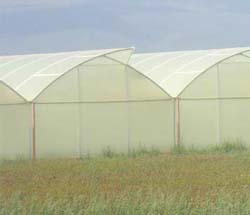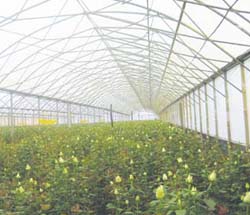 By manipulating environmental conditions, and paying equal attention to temperature and humidity, greenhouse growers can improve the quality of their crops and maximise yields.
By manipulating environmental conditions, and paying equal attention to temperature and humidity, greenhouse growers can improve the quality of their crops and maximise yields.
Greenhouse climate control involves optimising the elements to maximise yield at the lowest possible cost, and to do this properly, growers need to understand the effect of vapour pressure deficit (VPD) on plant growth.
VPD, explains Van Rooyen, is the difference between the amount of moisture within a plant’s leaves and the air surrounding the plant. It drives various plant processes, such as transpiration, the opening of stomata, and the uptake of carbon dioxide (CO₂) and nutrients.
“By managing respiration rate through VPD, one cannot only optimise plant growth, but ensure that plants stay stress-free and thus healthier. The process further optimises nutrient uptake, resulting in better yields,” he says.
Temperature plus humidity
Optimal VPD is achieved through the management of the humidity and temperature in greenhouse or tunnel structures. “When it comes to climate control, growers are normally more focused on temperature than relative humidity, which refers to the amount of water vapour in the air. Humidity, nevertheless, has a much greater impact on plant health and growth than temperature has. Both should therefore be taken into account when using VPD to manipulate plant growth.
It therefore means little to know the temperature in an undercover structure without knowing the humidity levels at that temperature. Unfortunately, there is no ideal VPD setting, as it fluctuates in accordance with relative humidity and temperatures.
You can’t measure humidity [levels] and temperatures in January and then set the VPD for the rest of the year, as variations between seasons, day and night, and different phases of plant development all have to be taken into account.
Aside from this, different crops thrive in different VPD ranges, and these also differ from one growth phase to another.
Young plants have a lower stress tolerance than older plants, and therefore function better at lower VPD levels than older plants do.
The goal with VPD, therefore, is to keep it in the sweet spot, depending on the type of crop produced, its stage of development, the temperature and relative humidity.
Broadly speaking, according to Van Rooyen, the recommended VPD for most crops ranges from relative humidity levels of 60% to 80% and temperatures of 18°C to 28°C, with a 10°C difference between day and night temperatures (click here to see table).
The exception is cannabis, where humidity levels of 45% to 50% are preferred due to the flowers’ high susceptibility to mildew. Another factor that has to be considered is dew point, which relates to the amount of water that air molecules can hold at certain temperatures.
Air molecules hold more water at high temperatures than at low temperatures. Thus, as the air temperature rises, the air can hold more water and its relative humidity (the percentage of water in the air) decreases, and vice versa. Exceeding dew point causes condensation and the release of free water, which, in turn, increases the risk of the development of fungal diseases.
Effects of humidity
Good climate control, specifically the management of humidity levels, goes a long way towards eliminating diseases. For example, high relative humidity at night followed by low relative humidity the next day is associated with powdery mildew outbreaks; while high humidity at night followed by high humidity the next day can lead to downy mildew. You have the same origin of disease, but environmental differences result in different outcomes. Humidity also influences the uptake of certain nutrients. Calcium and magnesium compete with one another, with the uptake of the former being negatively affected when the humidity level is low and transpiration high. This can lead to a calcium deficiency and, in effect, diseases such as blossom end rot in tomatoes and peppers.
Climate Control
The ideal would be the ability to manipulate VPD through the use of a computerised system in greenhouses and tunnels that automatically adjusts environmental parameters that influence temperature and relative humidity.
Unfortunately, we’re not there yet,. The latest controllers, at best, have a setting to measure VPD or alert growers when the VPD level falls out of a certain range.
Greenhouse design  Tools that a grower can use to manipulate temperature and relative humidity include heating, ventilation, air circulation, cooling and lighting. Nonetheless, everything starts with the design of the greenhouse, which includes the layout, orientation and materials used.
Tools that a grower can use to manipulate temperature and relative humidity include heating, ventilation, air circulation, cooling and lighting. Nonetheless, everything starts with the design of the greenhouse, which includes the layout, orientation and materials used.
When these are suitable, it is easier to manipulate the ambient factors at a low cost. To illustrate, photoselective plastic can be used to manipulate the light that enters the greenhouse, and in turn this could help to lower or raise temperatures.
Air vents can be opened to trap hot air or allow it to escape from the greenhouse, while ‘wet walls’ can be used to reduce the temperature of the air as it moves over special cooling pads and also increases humidity.
Mixing air
The mixing of air is important to achieve uniformity, and can be used to raise temperatures when necessary by mixing warm air trapped in the roof with the rest of the air in the greenhouse.
The air can be mixed into the greenhouse via different means, but laminar flow fans are preferable, as used with cooling pads, to turbulent fans.
The latter operate at a far greater air speed, which breaks up the microclimate around the leaves of the plant and results in increased transpiration. This, in turn, raises
humidity once more.
“If you’re going to use [turbulent] fans, you need to consider their impact on the plants and rather use them over shorter periods,” advises Van Rooyen.
Foggers increase humidity levels by releasing fine droplets of water. “The finer the droplets, the better. To prevent fungal problems, the water should evaporate before it reaches the plants.”
